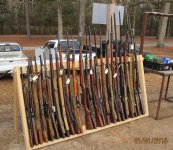Were any Enfield made in 1916 made in England and if so how could I know? Would there be a mark or something.
Enfield, Enfield, Enfield,,
The British SMLE (Short, Magazine Lee Enfield) was first produced in MkI form in England in 1904 . Cal 303
The MkI and MkI* were made into 1907 when the MkIII was introduced.
Still the 'SMLE', the MkIII was modified from the MkI rifles mainly in the way the charger bridge was made.
The MkI series used a separate right hand charger part attached to and sliding on the bolt head.
The MkIII dispensed with all that went to the very common rivited in place heavy, one piece over the top charger bridge.
Several Brit Arsenals made the Mk1 and the MkIII rifles including some like Sparkbrook that didn't survive the MkI era and others like the secretive Peddled Scheme rifles of WW1 wartime production.
The rifles were also made at the British Commonwealth Arsenals in India (Ishapor) and in Australia at Lithgow.
Lithgow rifles generally bring a premium. Condition of course is everything.
Lithgow never made the MkI series but instead started with the MkIII.
None of these rifles were ever called or marked as No1 MkIII until the mid 1920's.
That's when the British decided to number their battle rifles and No1 was attached to the SMLE
A 1916 dated SMLE should simply be marked on the socket MkIII or MkIII*(cut-off, volley sights, wind adj rear site elliminated on the latter).
(Rifles w/o the '*' (Star) marking bring more $$ as they have the goodies mentioned above, or at least are supposed to have them. Not uncommon for the Cut-off and Windage Adj rear site to be missing. The latter replaced with the later non adj site. Check ser# on the underside of the site tangent bar.
The No2 rifle was the .22rf conv of the SMLE
No3 was the Pattern 1914 .303
To come was the No4 Rifle in the late 30's along with the #5 (Jungle) Carbine version
The 1917 30-06 was the US Model 1917 Rifle cal 30.
Never was officially an Enfield but got the name from being a modification of the Pattern '14 British rifle.
SMLE's have gone up in price and value very quickly in the past few yrs.
Very good specimens are hard to find and like most US 1903's and 1917's, (and Garands and Carbines) most are now parts rifles.
That doesn't make SMLE's any less shootable. But for a collector, the mismatched parts (some ser#'d, many marked by Arsenal mfg and identifiable by era of mfg) very quickly lowers value.
SMLE's are usually covered in Proof, Inspector, Arsenal and Rework Marks & Dates.
Getting a good education on those is a good start to knowing what you have in hand and what it's worth.
You have to sort out the orig Arsenal rebuild part from the bubba/'smith/hobbyist replaced part.
.and like most of these Milsurps the parts are getting more expensive and harder to get. There's even some repro parts for them now they are so popular.
They are fun shooters, reloading for them is easy as any other CF cal.
They have a habit of generous headspace, but if you size & load your brass to your rifles chamber and then only neck size, you control the HS and have little issues..
You don't need a bunch of magazines though they are detachable. The mag was meant to be left in the rifle and reloaded from the open bolt with charger clips or single rounds.
None of these classic WW1 or WW2 rifles are getting any less expensive.
Passing on a good one for a decent price means paying a lot more for the same later on,,if you can find one.


